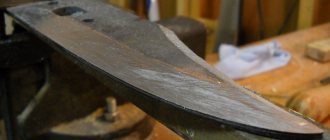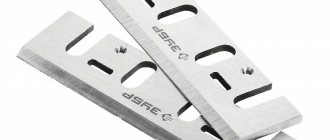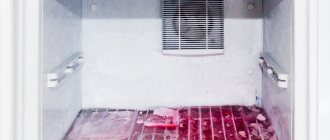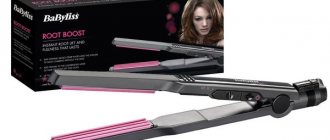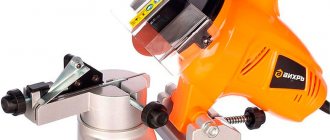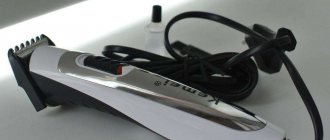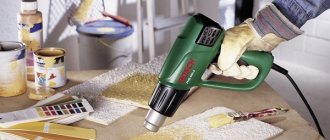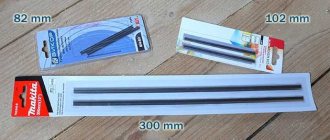Making a simple model yourself
All homemade devices for sharpening knives help to accurately maintain a given angle of inclination of the block to the blade, which is important for maintaining the functionality of the tool and obtaining a good cutting edge of the blade.
A machine designed by Lansky is easy to assemble yourself. To do it, you do not need special training or special technical knowledge. You will need a minimum of simple materials that are always at hand. In a store, such a machine costs about 1,500 rubles.
The operating principle of the Lansky machine is that the knife is securely fixed and processed at a given angle using replaceable sharpening attachments made of stone of different grain sizes. The result is a sharp blade edge.
Step-by-step master class
Required consumables:
- A metal rod with a diameter of 6 mm, which must be cut into rods of different lengths.
- Welding electrode for the manufacture of corner guides. It is completely cleaned of flux and sanded with medium-grain sandpaper.
- Carbon stainless steel 3-5mm thick for clamps. Through holes are made in them. Tip: machine oil will make it easier to drill slots in the plates. You can wash off the oil with a concentrated solution of soap residue.
- Metal corners measuring 9x9x0.6 cm.
- Fasteners: nuts, screws.
- Using a grinding machine with a diamond disc (grinder), the corners are cut, the edges of which are then smoothed with a file and sanded with sandpaper.
- Holes are drilled in horizontal and vertical planes.
- The bevels of the guide rail are processed.
- A stand is made from a bolt and nut. Then they secure it in a clamp or vice so that the entire structure is securely fixed.
- Assemble the entire device.
- Attach the abrasive and knife.
- Testing the device.
Blade sharpening rules
There are several subtleties that are important when sharpening knives:
Rating of the best knife sharpeners
| Nomination | place | Name of product | price |
| Best Manual Knife Sharpeners | 1 | Profi Cook PC-MS 1090 | 1 750 ₽ |
| 2 | Rondell RD-323 | 891 ₽ | |
| 3 | Fiskars 120740 | 850 ₽ | |
| 4 | TimA TMK-001 | 590 ₽ | |
| The best electric knife sharpeners | 1 | Chef's Choice 120 | 15 590 ₽ |
| 2 | KitchenIQ 50073 | 3 671 ₽ | |
| 3 | Sititek Hozjajka 31M | 2 790 ₽ | |
| The best knife sharpeners from AliExpress | 1 | Saim Fsda | 4 870 ₽ |
| 2 | Ruixin PRO III | 1 350 ₽ | |
| 3 | NUOTEN ND-073 | 680 ₽ | |
| 4 | Findking MDQ001 | 270 ₽ | |
| 5 | Knife Sharpener | 150 ₽ |
Device for sharpening from mounting angles
The prototype of a homemade sharpening device made from mounting angles is a drawing of the aforementioned professional Lansky sharpener.
To make such a device you need:
- metal plates 4x11cm;
- aluminum corners;
- metal rods 15cm long;
- bolts and nuts;
- tap for thread cutting;
- metal sharpening machine;
- vice or clamps;
- small file for fine sanding work.
You can do without a sharpening machine. It will be replaced by a file or any tool that can smooth out the sharp corners of metal structures.
- On the metal plates, according to the diagram, markings are made on where to drill the grooves.
- Threads are cut in the prepared tap holes.
- To make the sharpener comfortable, all surfaces of the metal structure are processed with a file: sharp corners are rounded, burrs are filed, edges are smoothed;
- Holes are drilled in the corners according to the drawing.
- Use a file to expand the space for supporting the rod.
- The holes are threaded with a tap.
- Nuts with a diameter of 6 mm are used to tighten the rods inserted into the outer grooves.
- A 14 cm bolt with a diameter of 8 mm is screwed into the expanded hole of the base. Before this, you need to screw a wing nut onto the bolt, and two nuts onto it. This bolt will be the support pillar of the entire structure.
- Bolts are attached to the remaining grooves. With their help the blade will be fixed.
- Nuts are screwed onto the rods, the corner is threaded and secured. The sharpening angle will be adjusted by raising or lowering the rods.
- A device for fastening an abrasive stone is assembled from a thin L-shaped metal rod, a threaded rod with a diameter of 6 mm, two holders and a wing nut. The outermost holder must have a through hole for the knitting needle.
This knife sharpening device is quick to assemble, easy to use, and has a wide range of sharpening angle degrees.
Best Manual Knife Sharpeners
Profi Cook PC-MS 1090
Rating: 4.9
In first place in the rating category is a desktop manual sharpener with abrasive made from a diamond grinding stone. It will handle sharpening effectively and quickly; you just need to place the blade in the slot with the tip pointing down, swiping it towards you several times. The sharpening angle is optimal, prevents damage to the metal blade and prevents the formation of scratches. There are three slots for different stages: preliminary, fine and coarse sharpening. This approach allows you to process even very dull knives. The case has a laconic design and is made of stainless steel. It takes up very little space, so you can store the sharpener in a drawer where spoons, forks, and knives are stored, then the product will always be at hand.
Advantages
- ergonomic shape;
- acceptable cost - 1650 rub.
Flaws
- not found.
Why is the sharpening angle so important?
The cutting wedge angle (the distance between the edges of the blade) is an important characteristic of any knife. It is set during production, depends on what function the cutting tool performs and varies from 55º (machete) to 10º (scalpel).
- for chopping and cutting hard materials - splitting bone, chopping bamboo, splitting coconut - you need a durable cutter with an angle between the edges of the blades of 45-55º;
- knives for separating meat from bones and cutting fibers with veins are sharpened at an angle of 40º;
- for a blade similar in functionality to an ax (it can be used to chop wood, chop meat, cut straw), an angle of 35-40º is typical;
- universal knives (hunting or fishing) are sharpened at an angle of 30-35º;
- for standard kitchen work (cutting bread, vegetables, cheese), an angle of 25-30º is suitable;
- for cutting fillets, the tool is sharpened at an angle of 10-15º;
- an angle of 8-12º is provided for the blade of a straight razor and scalpel.
In order for the knife to work correctly and serve for a long time, it is important to sharpen it at the right angle.
The best electric knife sharpeners
Chef's Choice 120
Rating: 4.9
In first place is an American-made electric sharpener, suitable for sharpening regular and serrated (serrated) knives. It processes the blade in three stages: in the first stage, rough sharpening occurs with diamond-coated abrasive discs, forming the first bevel; on the second - with fine-grained abrasive, a second bevel is formed; on the third, even finer ceramic abrasives grind and polish the blade, creating a third final bevel that is sharp. The user can independently choose a combination of steps to obtain different results. The sharpener can also be used for processing folding, hunting, tourist, sports, fishing and other knives.
Advantages
- power – 75 W;
- instant sharpening;
- sharpening angle control – 20 degrees.
Flaws
- high cost - 16 thousand rubles.
KitchenIQ 50073
Rating: 4.8
The second position is occupied by an electric knife sharpening device, recognized as the best in terms of quality and price. The model is much cheaper than the leader in the category, but is not inferior in quality and practicality. The case with a metal insert looks massive, so initially it seems that the device will weigh a lot, but this is not the case. The sharpener is lightweight and has a neutral design. There are rubberized inserts on the bottom so that the device does not slip on the table surface. Only knives made of stainless, alloy or carbon steel can be sharpened. Geared tools may only be processed in the polishing slot. Simple and clear instructions included.
Advantages
- synthetic and ceramic abrasives;
- Suitable for sharpening knives of different sizes;
- sharpening angle adjustment;
- ergonomic handle.
Flaws
- low power – 6 W;
- relatively expensive - 4600 rub.
Sharpening tools on an electric sharpener
Everyone who has a garage or their own home is forced to do repairs, during which they use all kinds of chisels, axes and other cutting tools. This means that there will always be a use for an electric sharpener: this tool is perfect for sharpening knives or scissors. It will come in handy if you need to sharpen a shovel, hoe or other garden tools, or sharpen a screwdriver. You simply need to have such a power tool in your own workshop. However, having it and being able to use it are not the same thing.
Device for sharpening knives with sandpaper
If you do not attach the sandpaper to a hard surface, it is difficult to use. There are various options for making a sharpening device. However, it is worth noting the most convenient among all. It has a beautiful appearance and high sharpness.
Necessary materials
A similar device consists of connecting sandpaper to ceramic tiles. This is a budget-friendly, reusable option. The paper is very easy to change.
This device will be made using:
- solvent or acetone;
- spray - adhesive;
- sheets of the required grain size;
- a piece of old fabric;
- rubber “bumper”;
- smooth ceramic tiles.
Sandpaper is sold in any automotive or construction stores. The optimal set will consist of:
- P800;
- P1000;
- R2000.
It would be best to use the smoothest tile that fits the size of the paper.
Sandpaper is selected according to size and grit.
Preparation and Cleaning
They are doing cleaning in the workshop. For this:
- The rag is moistened with acetone.
- Wipe the tiles.
- The solvent is not washed off.
- Be sure to ventilate the room after this stage.
Sharpening with sandpaper
Methodology:
- Spray the tiles and the back of the sandpaper.
- After 10 seconds, the materials are glued together.
- Press down with a press.
- Treat the blade for no longer than 5 minutes.
Correction of cutting products is very important. This is what contributes to the high sharpness of the blade. The angle must be maintained. The metal is polished. It is better for beginners to make edits using:
- ceramic bar;
- fine grained option.
What to sharpen tools on
To properly sharpen knives on sandpaper, you should know the basic principles of using a sharpener. But before you start sharpening the tool, you should understand what kind of electric sharpeners there are and how they differ.
The most common Chinese-made mechanisms are available for sale. They have two stones on different sides: one coarse, used for processing a very dull tool, and the other, with a fine abrasive, used for straightening or grinding the cutting edge.
The advantages of such a device include its relatively low cost, but the disadvantage is high speed. Operating such a device requires extensive experience. If it is not there, then sharpening the knife will turn into torture. The cutting edge will be wavy and the blade may show signs of tarnish. This indicates overheating of the metal during processing.
Universal machines are also sold in stores, but their cost is much higher. They have a gearbox that reduces the speed of the stone to 125 rpm - this allows you to avoid overheating the metal during processing.
When sharpening knives with a thin blade, overheating of the metal can completely damage the cutting tool.
More expensive machines are driven by a sanding belt, by changing which you can not only straighten the blade, but also polish it. Sharpening a knife with an electric sharpener with such devices will be easy even for a novice craftsman. There is less chance of overheating of the cutting edge and there is no urgent need for cooling.
How to choose the best one
When choosing an electric sharpening machine, you need to consider how often the device will be used, as well as whether other tools or equipment will be sharpened on it.
Device class
Sharpening machines are divided into household and professional.
The former are characterized by significantly lower power and low resource. They are designed for fairly rare, periodic use with light load. The latter contains a significant margin of safety. At many enterprises, machines are turned on for the entire work shift, so electric motors have cooling systems and are also equipped with bearings of appropriate quality.
Sometimes there is a separate category of semi-professional equipment. It occupies an intermediate position and is used in small businesses and advanced private owners.
Weight and size
The more powerful the machine, the larger it is. In order to place large equipment in a garage, workshop or office, you will need a lot of space. For occasional sharpening of knives, small electrical appliances can be used, which do not even require stationary placement, but are simply placed on any surface on a stand, held on it by non-slip legs and their own weight.
Good devices can be fixed in one place. For this purpose, holes or eyes are provided for bolts. Being installed through a rubber mat or sealing washers, the machine receives the necessary immobility with minimal transmission of vibrations to the working surface.
Power
For home devices that are intended only for small objects with a small cutting edge area, there is no reason for high power. Many tabletop machines cost 100, 160, 200 watts. But for devices that will be installed on a workbench in the garage and will serve not only for tidying up knives, but also axes, as well as other garden tools, it is better to choose motors rated at 400 - 600 W.
Expert opinion
Levin Dmitry Konstantinovich
Devices larger than a kilowatt do not make sense in a household, but they can be useful as standard equipment in small mechanical workshops.
Speed
Most standard AC induction motors are high speed. This means that they will spin the disk at high speed. This will allow you to quickly get the desired result, but it requires more concentration, since at high speed you can easily remove the “extra”.
The main disadvantage of high-speed machines is the risk of overheating of the workpiece. If the steel has rainbow streaks, this is a sure sign that it is “burning.” In the process of such sharpening, the hardening of the product is released, and the knife subsequently becomes dull very quickly.
Which knife sharpening machine would you choose?
ManualElectric
The spindle speed of most household machines is from 2.5 to 5 thousand revolutions per minute. Sometimes you can find universal sharpening machines with 1500 rpm. Some devices are designed with a reduction gearbox for one of the circles. It doesn't just spin slower, its casing can fill with water to cool it down.
Some models may have smooth or stepped speed control.
Additional features
Some sharpening machines have special adapters so that a sanding belt can be installed instead of a wheel. This significantly expands the functionality of the device.
Other products may have a flexible power take-off shaft as an option. Any equipment designed for an external drive can be connected to it. Most often this is an engraver.
Pay attention to the additional equipment if you plan to use it.
How to sharpen knives using sandpaper
Sharpening a knife on an electric sharpener is a rather difficult operation. To get a good result, you need to know some subtleties.
- First of all, you need to carefully examine the blade. We pay attention not only to how much it is blunted, but also to the angle at which the cutting edge is sharpened. When working, it is necessary to maintain the specified sharpening angle. In this case, a special device will help, allowing you to change the angle depending on the tool being sharpened.
- If a preliminary operation is necessary, which is performed on a rough abrasive wheel, then the cutting edge is positioned towards the movement of the stone. When polishing work is carried out, the cutting part should be positioned in the direction of rotation of the stone.
- During sharpening, the blade is carefully moved from side to side. You should constantly ensure that the entire surface of the edge is processed evenly.
- Before starting work, it is determined which stone needs to be used to perform the operation. For very dull blades, use coarse abrasive wheels first, and then finely edit.
- When working with a high-speed sharpener, you should be careful not to overheat the edge. Otherwise, you can damage the knife irrevocably. To prevent this from happening, the workpiece is periodically cooled by lowering it into a bath of water. Also, do not press the part too hard against the abrasive.
The presented video clearly shows an example of edge processing on a machine using a mandrel:
You can also perform more complex operations on an electric sharpener, for example, making bevels on a knife. This work is carried out during the independent production of cutting tools. They can have different geometries, depending on its purpose.
It is impossible to sharpen slopes on emery without a suitable mandrel. Slopes can be straight or concave. Special devices are used for their manufacture. They are made independently, because... Due to low demand, they are supplied to the retail chain in limited quantities. An example of the device is shown in this video:
Types
The basis of sharpening a metal blade is the impact on it with the help of granular materials. The roughness rubs against the steel, removing tiny particles from it. As a result of repeated repetition, the surface becomes thinner, which, if the right angle is observed, gives a razor sharpness. In order to achieve this effect, two types of machines can be used.
Manual
The operation of a manual sharpening machine is based on the same effect on the knife of a special abrasive stone.
The purpose of the machine is to secure the tool being processed and the sharpening stone. This gives accuracy and repeatability of such a parameter as the sharpening angle, one of the most important for good sharpness. The design of the manual machine is simple and elegant: it is a frame that can be steel or wood. With the help of adjustable devices, it can be set at a certain angle to the surface on which it stands.
At one end of the frame there are clamps for the knife, and at the other there is a perpendicular mount for the movable rod on which the block is attached.
As a result of the adjustment, the knife is set at the desired angle. After this, the rod with the bar, under the influence of muscular force, makes translational and slightly pendulum movements.
A manual machine is a device for making sharpening with a whetstone precise and the result predictable. Perfect for those who don’t have too many knives and can’t sharpen the blades properly. The device does not require any additional costs, except for the purchase of new bars, which will not be needed soon. The rest of the time it can lie in a desk drawer, unassembled, without taking up much space.
Electrical
The electric sharpening machine operates from a household network of 220 V (industrial - from 380 V). Its basis is an electric motor in a housing. There is a thread at both ends of its shaft into which abrasive wheels of the required grain size are installed. The circles are covered with casings, and for safety purposes, transparent plexiglass visors are made on top so that grains of abrasive do not get into the eyes.
When the machine is turned on, the electric motor spins the wheels, and the operator leans the knife against the end of the wheel at the desired angle and sharpens.
Most often, sharpening machines are equipped with two wheels of different grain sizes. One, rougher, is used for sharpening a dull blade, the second, almost smooth, is used for finishing.
You can independently install a polishing disc on the machine spindle and, in combination with GOI paste, achieve a mirror-like shine of the product.
The main problem that you may encounter when using electric equipment for sharpening knives is setting the desired angle. For this purpose, the machines are equipped with special rotating bars with clamps. More expensive devices have a movable table that is adjustable in several planes. With its help, you can get an ideal cutting edge not only on knives, but also on drills or teeth of milling cutters and circular saws.
Advantages of electric sharpeners
Electric knife sharpening machine is very popular. It allows you to sharpen a blade of any length and thickness with high quality, accurately maintaining the desired angle. Modern electric machines automatically detect the inclination of the blade. The device perfectly sharpens knives with wavy blades.
Another advantage of this device is its versatility. This machine can be used for sharpening scissors, screwdrivers and other sharp tools. After grinding the blade looks like new.
Typically, electric machines consist of several abrasive discs located perpendicular to the blade and guide elements. Sharpening a knife on such a device is carried out in one motion. More complex models have several sets of discs with different grain sizes.
An important advantage of sharpening machines is their long service life. Basically, such devices are equipped with sharpening elements with ceramic or diamond coating. Even with everyday use, the need to replace such knives is extremely rare. Homemade knife sharpening machines may never be repaired.
Using a whetstone
With this method, you need a double-sided block, one side of which is intended for direct sharpening, and the other for final finishing:
- Place the whetstone on a flat surface with the “rough” side up;
- secure the blade using a magnetic holder;
- smoothly and without much pressure we move the cutting part of the knife at an angle of 30 to 45 degrees (depending on the manufacturer) from one edge to the other of the block at least seven times;
- turn the block over with the fine-grained side up;
- We carry out the final finishing of the blades to a mirror shine;
- thoroughly wash, dry and install the lubricated knives on the machine.
Universal sharpening tool
For sharpening European and Japanese products, there is a universal machine for sharpening knives and scissors with three stages of the process. The first one processes knives with a sharpening angle of up to 15 degrees, the second one – 15-20 degrees. The third uses composite discs that create a microscopic angle. This processing allows you to create a thin cutting edge.
This type of machine is suitable for sharpening kitchen, travel and pocket knives.
Adjustment
Each of these four options for sharpening hair clipper blades is available at home. However, even perfectly sharpened blades will not work correctly if they were installed without adjustment when assembling the cutting part:
- the serrated edge of the upper blade should be shifted 1-2 millimeters horizontally relative to the serrated edge of the lower knife;
- the cutting part of the first tooth of the moving knife in the longitudinal plane is in line with the serrated edge of the stationary blade.
The service life of a modern trimmer can really be significantly extended. To do this, you need very little - remove, remove dirt and lubricate the blades after each haircut, and also master simple techniques for sharpening and adjusting knives.
Source: tehnopanorama.ru
Blade lubrication
Immediately after sharpening, knives should be lubricated with oil. You can use both professional (sold in hairdressing stores) and regular silicone grease for electrical appliances. Do not lubricate knives with sunflower, olive or other edible oils. If you do not have a suitable lubricant at hand, it is better to abandon the treatment altogether, postponing it for later.
To apply oil, prepare a container with a narrow spout (professional products are sold in such packages) or a syringe with a needle.
Lubrication of knives is carried out as follows:
- Remove the blade block and extend the blade.
- Using a brush, clean the knife block from dirt (hairs or dust after sharpening).
- Wipe the knives with a soft, dry cloth (for example, microfiber or glasses).
- Apply 3-4 drops of oil to the surface of the blades, as well as two drops on each side of the base of the knife block.
- Insert the blade block back into the machine.
- Turn on the machine for half a minute. The oil will be evenly distributed over the surface of the blades.
Lubrication is best done regularly, every two to three haircuts. This way the machine will serve you for a very long time - the oil protects the knives from rapid dulling, overheating and contamination.
Video: how to lubricate a hair clipper
Timely sharpening of knives will help you extend the life of the knife block. Don't neglect this procedure - it will help you save a lot of money on buying new parts.
Source: afrodita.guru
On a professional machine
This option is more suitable for hairdressers whose working tools require regular - at least 4 times a year - and high-precision sharpening. At the same time, the high quality of this process can only be ensured by a special machine, which significantly reduces the time for this procedure.
The algorithm of actions in this case looks like this:
- remove the knives from the trimmer;
- cover the sanding disc, cleaned of dust and dirt, with an even layer of abrasive paste;
- fix the knife on the magnetic holder with the cutting edge down;
- we start the machine at a certain speed (indicated in the instructions);
- We bring the knife to the wheel and begin the sharpening process, using smooth movements of the blade, the teeth of which should be directed against the movement of the grinding disc, from the edge to the central part.
The main disadvantage of this method is the high cost of a professional machine and consumables.
When do knives need to be sharpened?
However, sooner or later, home hairdressers are faced with a serious problem when the blades of hair clippers become so dull that it becomes simply impossible to do a normal hairstyle. There are two ways to solve this problem. Buy a new machine or try sharpening the blades yourself. The second option looks preferable, since there are at least four effective methods that allow you to sharpen any cutting surface yourself.
Modern trimmers are equipped with steel or ceramic knives, the cutting part of which is often coated with a protective layer of diamond, titanium or carbon coating. However, even such durable blades lose their sharpness with frequent use, which leads to the following problems:
- straightening your hair becomes very difficult;
- while cutting, the cutting part of the device begins to tug and wrinkle the hair, causing unpleasant pain;
- At the end of the procedure, the skin on the head is severely irritated, up to small cuts.
There are several ways to fix this problem, but they all start with disassembling the machine:
- disconnect the knife block from the body;
- unscrew the screws;
- separate the blades;
- We clean the cutting and working parts from dirt and hair residues using a special brush or a clean rag soaked in water.
After disassembling the cutting unit and cleaning the blades—a process that should be done after every haircut—you can move on to one of four effective types of sharpening.
